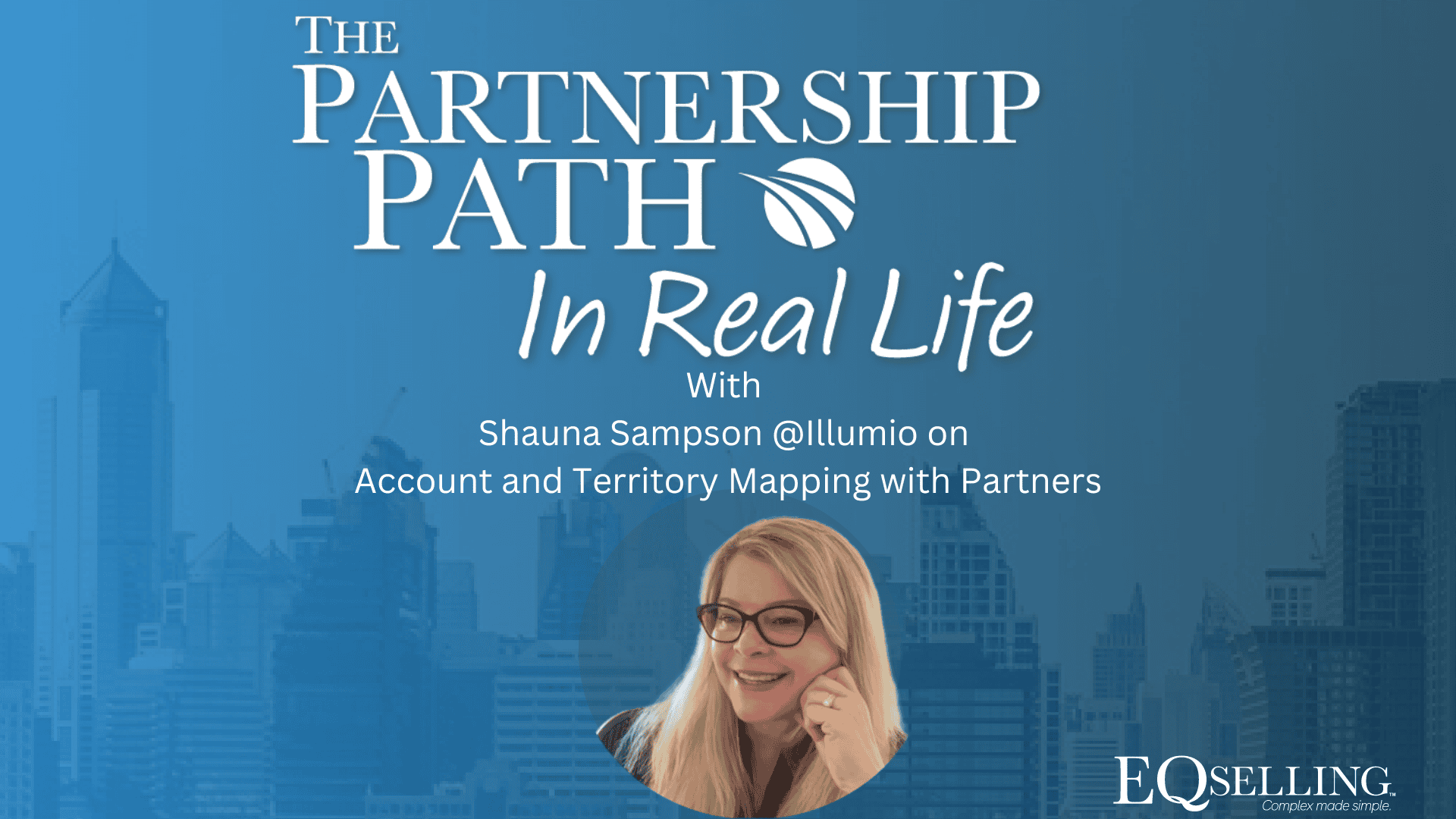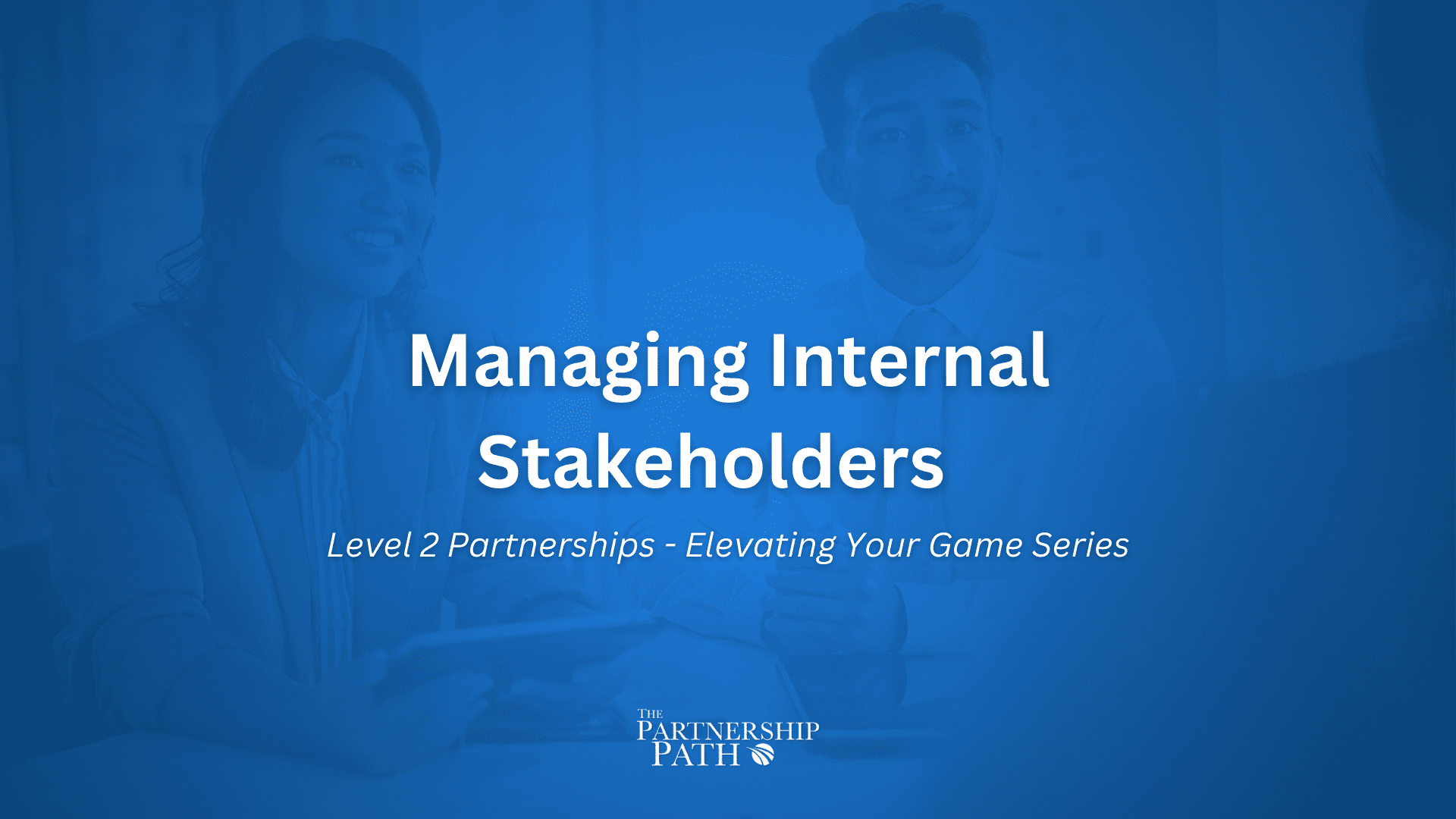Main Episode
Account and Territory Mapping with Partners
Episode Summary
Today, we delve into the complexities of account and territory mapping with partners, dissecting key statistics, and sharing practical strategies for effective territory alignment. If you’re navigating the challenges of sales and partnership dynamics, this episode is a must-watch. Sharing these insights is invaluable for anyone looking to enhance their partnership management skills and drive success in their roles.
Transcript
Toni: Hello John.
John: Hi Toni, how are you today?
Toni: Well, I am thoughtful today because I’ve been chewing over, mulling over, something that you said to me after our last episode where we talked about marketing. So, one thing that people love.
John: Okay. Uh oh, what, am I in trouble?
Toni: Actually, so when it comes to marketing and certainly in lots of the content that I’ve worked on, love and analyst statistic. And yeah. And I had spoken about a statistic, which said that 70% of people don’t want to interact with a salesperson until quite late on in the sales process.
John: Oh yeah.
Toni: You’re a pragmatist and I’m open-minded and an optimist. You had some really interesting thoughts on that and how we can question, challenge, or think critically about what we read in that regard. So I thought it’d be worth us kind of, or you sharing what you shared with me when we spoke after the last episode.
John: Sure. Yeah, yeah, absolutely. Look, now I’m glad you brought that up, because I do remember saying that to you. And look, what this, the statistic gets, that particular statistic from Gartner gets kind of morphed in a lot of different ways. You just a minute ago said it one way, which was that 70% of the people don’t want to engage or whatever. I’ve also heard it as, customers are 70% of the way through the sales cycle before they engage with a vendor. I’ve also heard it as customers are 70% of the way through their decision by the time they talk to a salesperson. And that alone, I think, raises some questions about the actual statistic, right? That people are repeating it in a variety of ways. And I also think…
Toni: Hmm.
John: …when we hear an analyst, you know, statistic or result or, you know, their conclusion or whatever, I think it’s healthy for us to kind of put our own analytical hat on and kind of challenge that a little bit and make sure that that resonates for us. And that particular one rubs me very rough, right? Because I think that, I think that here’s what I think I said to you that day is I think that customers used to contact vendors earlier in their process to get material because that was the only way they could get material. You and I are both old enough to remember before everything was on the internet and we actually sent brochures and all that kind of stuff to people. And so they would contact the vendor, but they weren’t actually in a sales cycle yet.
Toni: Yeah. Yeah.
John: They were investigating, which they still do today, and they do a lot of investigating today. Now, the internet means that there’s a whole lot more information out there for people to investigate and educate themselves. But where it rubs me the wrong way is when people say that the sales cycle is 70% complete by the time a salesperson gets involved. And I don’t think that’s even remotely true. I certainly don’t experience that in my own business.
Toni: Yeah.
John: As you know, my business has both an indirect channel side and a direct selling side. And we certainly don’t see that with our customers either that somehow these buyers are almost done in their decision when they engage with a vendor. That’s just not true. It makes for great analytical research and it’s a great push for content marketing, which I am a big believer in. I think it’s super helpful. I just sometimes I think those statistics get a little overused maybe or wrongly used and that kind of bugs me.
Toni: And, and I did, that’s why I was really keen for you to kind of share that because you’re right. We need to be able to think critically about, you know, the statistics that are shared and, and certainly the role of the, the sales person or the, or the account manager or territory manager. It’s really important. I mean, we wouldn’t have any, I guess if customers were already done by the time they spoke to the sales person.
John: Right, we practically don’t need salespeople. Then we just need order takers, right? And that’s not true. My favorite example of this, by the way, is the Challenger sale. I don’t know if you ever read the Challenger sale book. So it was a book that was written by two Gartner analysts who had a ton of data. And then they left Gartner and they took all that data. And then they created this book called the Challenger sale, which was, it was a very popular sales methodology, and still is today. But when I, as a technical guy, when I read their research, I could draw slightly different conclusions from a lot of their data. Like I get how they got to their conclusions, but I can read their data and go, I could also conclude something different. And I think that’s true of all the analyst stuff. If you get to the data and you really look at it critically, you could probably draw multiple conclusions that aren’t necessarily complimentary. Sometimes they’re even conflict. And so you just always have to remember the analysts have a job, right? And you have a job too, which is to look critically at that stuff and kind of figure out what really makes sense for your market. There, I’ll get off my little preaching stool for a minute.
Toni: Well, I mean, this is what makes it interesting. You’ve got to have an opinion, haven’t you? You’ve got to have an opinion.
John: You do. And I’m terrified of having an opinion, by the way. Like me just now putting that out there. The challenger salespeople are gonna probably hate me and I’m always afraid of putting opinions out there. So anyway.
Toni: Well, I think that you kind of teed it up nicely for our plan for today, which is to talk about account and territory mapping. Because something that I know is true is that the way one organization draws its territory will be different from the way another organization might draw its territory. And certainly from having that vendor experience where parts of the business were organized by geography for small business organized by geography, but for enterprise business organized by industry. And then you might even have a sales team that are organized by solution. Then you’ve got matrix selling. So how do you, as a partnerships manager, territory manager align, what could be something completely different to what your partner has is their own account territory.
John: Yeah. Yeah, look, this is, it’s super complicated, right? This is, I think this is one of the most complicated parts of any kind of partnership is that account mapping, territory mapping kind of grid that has to be put together because it’s not just that the two organizations have different lines that are drawn, but those lines are often related to compensation, right? And so, I’ve got a territory that I get paid for. And if when I sit down with my partner, their lines are different and half of what they want to go after is outside of my line, I don’t get paid on that. And so that colors the way I approach it. And so I think it’s super complicated. And we have to acknowledge that that is the reality, is that compensation comes into play here. And it’s going to impact how both parties come to the table and want to engage together.
Toni: Yeah. So, do you think that it’s okay to ask what do you get compensated on?
John: 100%. Not only is it okay, it’s expected. Like, if, you know, we talked about this early on in some of the episodes, right? Which is, if you’re gonna be a partner, that means transparency. That means being honest about why am I here and what do I get out of being here? And that does translate down to some personal level. Now, saying, hey, look, here’s how I get compensated, here’s my boundaries, all of that, doesn’t give you the right to never do anything outside those boundaries in the name of the partnership. But I think understanding and communicating, here’s what I care the most about, here’s what you care the most about, I think that’s, it’s a requirement of partnering, not just an okay thing, I think it’s a requirement. I’m really being very opinionated today, aren’t I?
Toni: Yeah and that’s really refreshing. Well and I think it’s really refreshing to hear because there is from a kind of British sensibility that oh god I can’t talk about money but you you can say what do you get compensated on but you don’t have to ask how much do you get compensated and I think doing that actually does give you the opportunity to tag teams with colleagues across the business. So an approach that, you know, you kind of get is that, you know, we would call it one Microsoft. So you might have someone that is OEM, someone that is Azure, someone that is, you know, you kind of look for, okay, I don’t get compensated on that part of my partner’s priorities, but those people do. So how do we align and bring them in?
John: Right. Yeah. Yeah, I think that’s exactly right. It’s about, just like everything else we’ve talked about, it’s about coming to the table and being transparent about here’s how we’re organized, here’s where our lines are drawn, here’s how that impacts compensation for people, here’s the kind of motivation that you’re going to come across. And now given that, how do I help you partner bridge to things that I don’t care about or I’m not motivated to help you with? but how do I help you bridge it? And then how do we together maximize where we do have common interests and common goals? So I think that’s exactly right.
Toni: So what would you say is a good place to start when you’re looking to have those conversations and understand those lines, especially if you’re going into an unknown, what kind of research would you do to find that out?
John: Yeah. So I think there’s probably, so I’m going to back up for just a second. So we talk a lot about communication, transparency, all those kinds of things. And I think that starts from the beginning. When you’re engaging with a partner or if you’re the partner account manager, whatever, there should be early on discussion about, all right, let’s talk about our organizations and the way they’re structured and the way our lines are drawn. That’s like early days, and that means that it has to be a relationship. And I’ve said this multiple times throughout these episodes. The relationship is the most important thing. And that’s a relationship that’s built on communication, transparency, and honesty. So early days, let’s talk about how our organizations are structured, how our lines are drawn, all of that stuff. So that’s early days. If you don’t have that and you come to the table and you’re now partnering with somebody and you don’t have that, you know, the very first thing is to sit down with them and have a relationship building conversation. So, I always joke that the first time I ever sit down with a partner, I don’t talk about business at all. Right? I talk about how’s it going? What’s the weather like? All that kind of stuff. Because it’s the relationship that’s going to matter. Once we start building that relationship, now we can start having the conversation about, hey, let’s talk about how our organizations are structured. Let’s talk about what that looks like. Let’s talk about where our lines are drawn. Let’s talk about how you get compensated and how I get compensated. And it’s probably going to be a series of conversations, but it has to start with just relationship and then we start building into the business.
Toni: And there is a place where you might have to sort of navigate maybe changes in that landscape. So I know that I had partners where there was a significant period of flux, you know, acquisition, new leadership. And it can be frustrating if you are someone that is trying to maintain those relationships. So what are your thoughts on navigating change where things might feel quite in flux for both parties?
John: Well, I think that’s a reality, right? And I think the first thing is to acknowledge it. If we’re going through a change, there’s some people who are going to do what you just said, right? They’re going to be like, oh man, everything’s in flux and they’re going to get frustrated. There’s other people who are going to be like, wow, what an opportunity, right? So we have to decide who we’re going to be and I think our job is to be the second one, right? Our job is to say, wow, okay, everything’s in flux and that’s, that could be bad. But it also means everything’s up in the air and we can grab onto new opportunities and new ways of doing things. And I think it’s our job to do that and to help our partners through that. So I think first thing is you have to acknowledge and just be honest, okay, things are changing and we’re going to have to navigate this and navigate it together. And the second thing is figure out how we help each other through that. What is it that you need, partner, to navigate this? What is it that I need from you to navigate this? And then let’s figure out what those needs are, see if we can find some common ground and make sure we’re doing it together. Because I think the best partnerships survive that kind of thing because they find ways to do it together. And I think that’s the whole key to it. It’s a great question. And I think this is true in every business, right? Change is a reality. So we just have to embrace it and kind of move forward with it.
Toni: Well, that’s a great way for us to wrap this episode, I think. And maybe next time we can dig into some more examples and experiences of navigating change. Does that sound good to you?
John: I think that sounds awesome. I would love that. And I think that’s a great way to wrap it up. So thank you, Toni. Appreciate it.
Toni: Thank you, John.
Key Takeaways
- Critical Analysis of Statistics: Question and understand the statistics you encounter. Misinterpretations can lead to flawed strategies.
- Importance of Transparency: Open communication about compensation and priorities is crucial for successful partnerships.
- Strategic Territory Mapping: Aligning territory and account mapping effectively can overcome compensation conflicts and drive mutual success.




